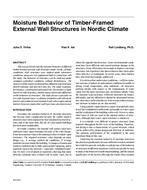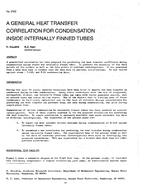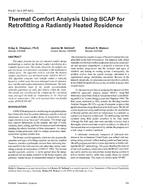Track: Controls
Sponsor: 1.4 Control Theory and Application, 4.5 Fenestration, MTG OBB
Chair: James Coogan, P.E., Associate Member, Siemens Industry, Inc., Buffalo Grove, IL
Moving toward sustainability, designers increasingly select systems that work with nature, rather than against it. Free cooling is routine today. Daylighting and daylight harvesting are moving into the mainstream. Natural ventilation for commercial spaces is uncommon, but it will grow. This session explores control systems for spaces with natural ventilation and natural light. When nontraditional systems are selected, they bring new control issues. Topics include control strategies, control devices, occupant interfaces and system architecture. Practical aspects of integrating new functions in a unified Building Automation System are discussed. Implications include the occupant’s experience, along with costs of construction and operation.
1. Engaging Users in Natural Ventilation in Mixed Mode Buildings
Glenn Friedman, P.E., Fellow ASHRAE, Taylor Engineering, Alameda, CA
Using natural ventilation is a primary strategy for low energy design. A common strategy is to combine natural ventilation with active heating and cooling systems resulting in mixed mode buildings which inherently have an additional level of control sophistication. This presentation tracks three case studies of the success and lessons learned from mixed mode buildings. The presentation reviews how occupants engage with and interpret mixed mode building operations including successes and learned experiences.
2. Reducing Uncertainty When Controlling Natural Ventilation
Stephen Ray, Ph.D., P.E., Associate Member, North Park University/SOM, Chicago, IL
As more buildings strive towards net-zero energy consumption and seek to connect occupants with nature, natural ventilation is attracting more interest. This presentation explains the benefits of natural ventilation and the corresponding control design objectives. Challenges and lessons learned will be shared from a mid-rise office building, university dorms, several condos and academic buildings including sensing, occupant behavior, BAS interfacing, controlling night purge, tenant complexities and optimizing hybrid systems. The completed projects illustrate another practical key to success: designing control strategies that survive value engineering.
3. Integrated Room Control for HVAC, Lighting and Daylighting
Klaus Jank, Siemens BT, Buffalo Grove, IL
Using natural light in buildings can save energy but only if systems are controlled to accomplish the savings. Natural light can enhance the occupant’s impression of a space but only if they can adjust it to suit their preferences. A state-of-the art control system for lighting and dynamic shading handles diverse considerations: inputs from occupants, dynamic daylight conditions, thermal and electrical energy flows, scheduled and unscheduled use of the space. This presentation explains control features and the advantages of implementing them in an integrated BAS. Data from recent projects illustrates the benefits.
Presented: June 27, 2017, 8:00-9:30 AM
Run Time: 90 min.
This is a zip file that consists of PowerPoint slides synchronized with the audio-recording of the speaker (recorded presentation), PDF files of the slides, and audio only (mp3) for each presentation.
Citation: ASHRAE Seminar Recordings, 2017 ASHRAE Annual Conference, Long Beach , CA
Product Details
- Published:
- 2017
- Units of Measure:
- Dual
- File Size:
- 1 file , 140 MB
- Product Code(s):
- D-LB17Sem36


